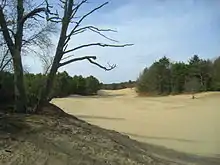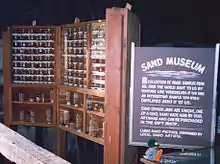Desert of Maine
The Desert of Maine is a tourist attraction whose main feature is a 40-acre (160,000 m2) expanse of glacial sand dunes, surrounded by a coastal forest, in the town of Freeport, Maine, in the United States.[1] The Desert of Maine is not a true desert, as it receives an abundance of precipitation, and the surrounding vegetation is being allowed to encroach on the barren dunes.


The land that encompasses the Desert of Maine was purchased by the Tuttle family in 1821. Like other Maine farmers of the era who were struggling to compete in an expanding agricultural market, the Tuttles’ methods of farming gradually depleted the soil of essential nutrients. Combined with overgrazing by large numbers of sheep, the widespread erosion of the Tuttles’ topsoil exposed a deposit of glacial sand that was lying underneath.[2] The initially exposed small patch of sand gradually spread and overtook the entire farm. The Tuttles abandoned the land in 1919 when it was purchased for $300 ($7.50/acre) by Henry Goldrup, who converted it to a tourist attraction in 1925.[1]
The site is preserved as a natural curiosity,[3] hosting a gift shop, a sand museum, and a farm museum.[4]
See also
References
- Casey, Maura J. (2006-09-22). "The Little Desert That Grew in Maine". The New York Times.
- Lear, Alex (24 February 2020). "Sifting History's Sands". Portland Press Herald.
- Bahr, Jeff (2009). Amazing and Unusual America. Chicago, Illinois, USA: Publications International, Ltd. p. 9. ISBN 978-1-4127-1683-3.
- "Desert of Maine". Desert of Maine. Retrieved 2009-07-25.